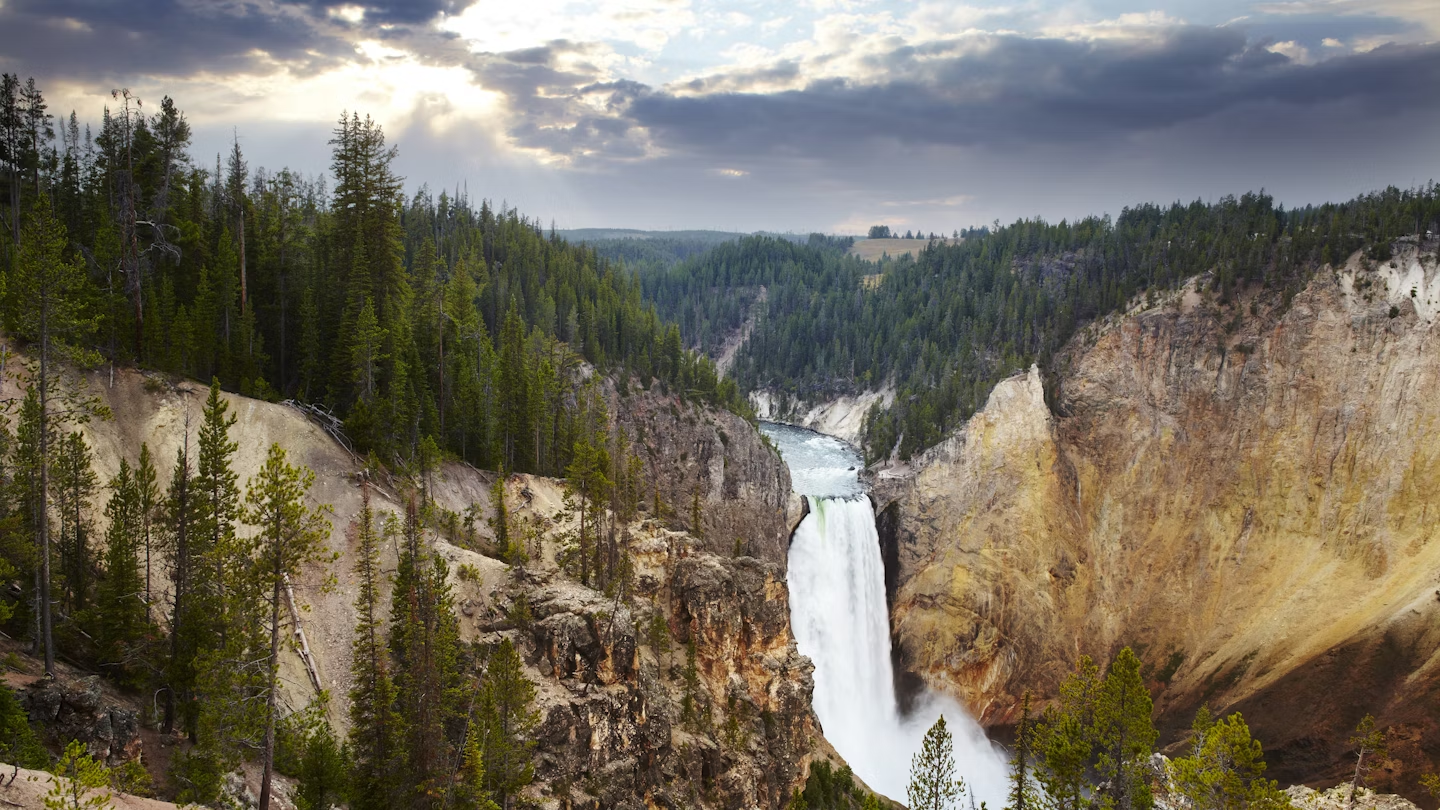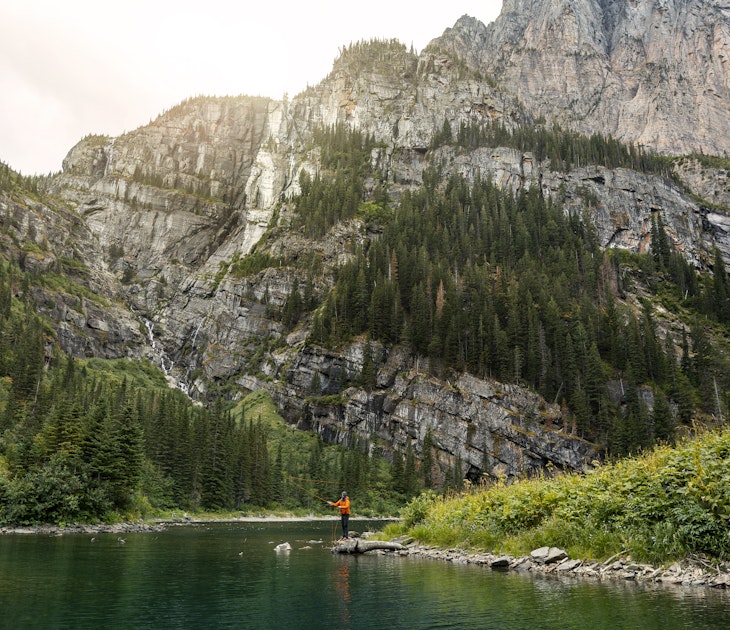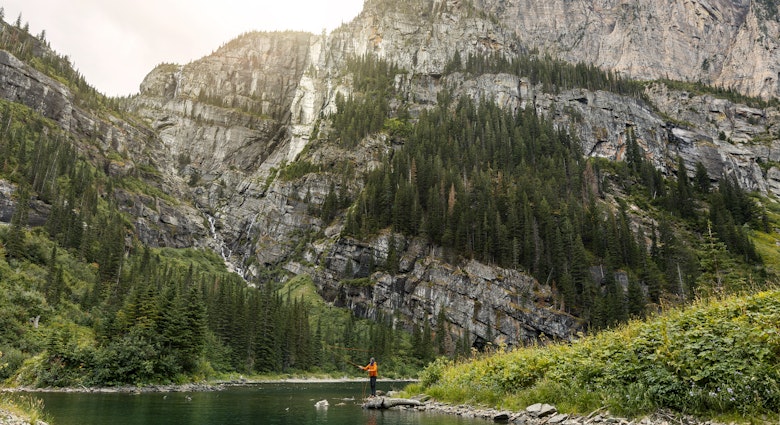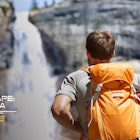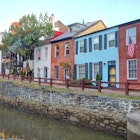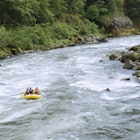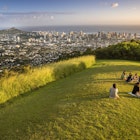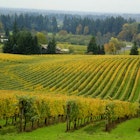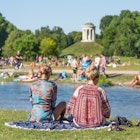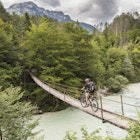This place was named not by the French fur trappers who wandered through in the late 1700s looking for pelts or by John Colter – the member of the famous Lewis and Clark Expedition who struck off on his own and stumbled across a place so uncanny his reports of what he saw were dismissed as pure fantasy. Yellowstone was named by the Indigenous Hidatsa people whose phrase Mi tsi a-da-zi called attention to the unusual hue of the stones lining the Yellow Rock River.
For thousands of years, Yellowstone's unique landscape has changed in ways both dramatic and minute. It's also continued to attract visitors, whether they're the ancestors of the Hidatsa following winter game, colonial-era settlers, or vacationing families on a classic summer road trip. There's certainly no bad time to visit Yellowstone. Open ten months out of the year, there's something new to experience in any season. And while some elements like wildlife and weather can be unpredictable, one thing is for sure. Whether you're visiting for the very first time or you've come back again and again over the years, you're in for a treat whenever you set foot in the park.

From strolling the Upper Geyser Basin boardwalk to see famous spouts like Old Faithful or making your way through the mist around Grand Prismatic Spring to enjoying a winter safari through the Lamar Valley and cross-country skiing to Lone Star Geyser, there's a little something for everyone.
Here's what you need to know to start planning your trip – and for more detail pick up a copy of the Lonely Planet Yellowstone and Grand Teton National Parks travel guide and Yellowstone National Park Planning Map.
Editor's note: Due to the COVID-19 pandemic, Yellowstone National Park began a phased reopening on June 1. Services and facilities will remain limited through 2020. Check the national park website for the latest info.

About Yellowstone National Park
Millions of years ago, this was a fairly ordinary swath of rivers, mountains, and grassy valleys. But then a geologic hot spit that once sat underneath what is now Idaho's Craters of the Moon National Monument shifted to the northeast where the Rocky Mountains meet the Snake River Plain. A long, slow drift to the confluence of what is now Wyoming, Montana, and Idaho and one cataclysmic eruption later, the place we now know as Yellowstone was born – including its famous geysers, hot springs, and travertine falls.
Since then, Yellowstone's living, breathing landscape continues to evolve. Beneath the boardwalks tourists criss-cross to see the park's thermal features, under the rolling rivers and the paws of bears and wolves is a vast super caldera, the mouth of a series of massive eruptions, the last of which occurred as recently as 630,000 years ago. The park's colorful, superheated paintpots, springs, and boiling rivers are the product of ongoing volcanic activity underneath a thin layer of the earth's crust, while its dramatic canyons reveal where the Yellowstone River has carved through millennia of hardened lava flows that have built up stunning basalt cliffs and ridges.
The Indigenous tribes who wintered in Yellowstone specialized obsidian tools made from all that abundant volcanic material endemic to the area. These arrow and spear points were so highly prized that they have been found in archeological sites far east of the Mississippi, working their way down long, well-established trade routes between tribes. Despite the unique landforms and abundance of resources, however, Yellowstone didn't attract serious interest from white colonizers until after the Civil War, when the Cook-Folsom-Peterson Expedition arrived in 1869.
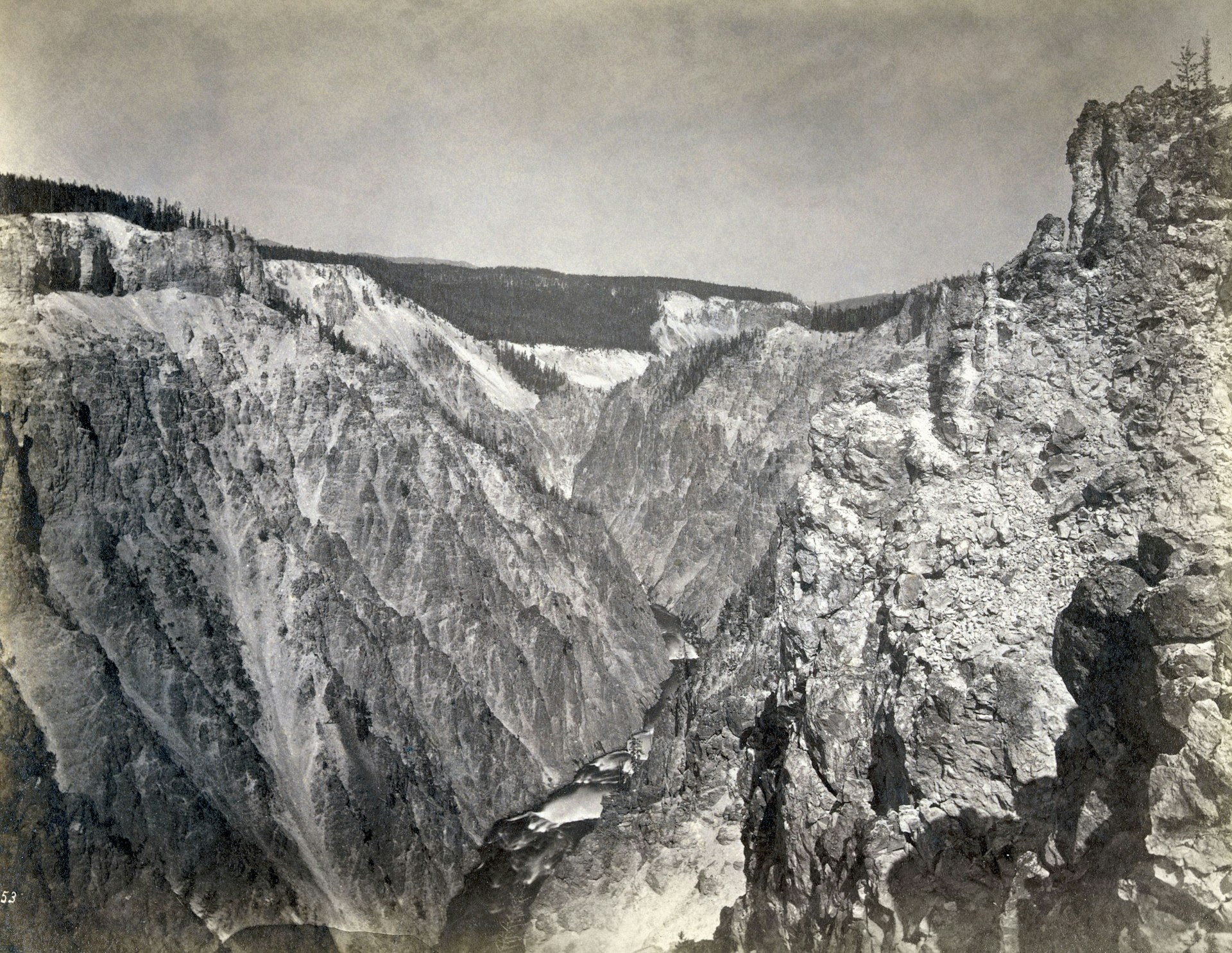
Unlike previous visitors from back east, whose accounts were taken as the stuff of myth, fantasy, and salesmanship, the Folsom party's accounts of what they saw in Yellowstone were taken seriously, backed up by maps and detailed surveying notes. It didn't take long for colonial settlers who'd arrived in the region on the heels of so-called Indian Removal to begin advocating for preserving the area, rather than opening it up to private developers for logging and mining.
Those recommendations were quick to reach the U.S. government in Washington D.C. By 1872, photographs and paintings by artists like Thomas Moran were amazing the public back east and won over not only the populace, but politicians, too. President Ulysses S. Grant made Yellowstone the country's first national park that year expressly "for the benefit and enjoyment of the people" – a surprising choice in a rapidly industrializing nation that often saw wilderness not as a playground, but a resource to exploit.

The decision to establish Yellowstone as a national park had stunning implications, and arguably ushered in the first real era of American tourism and outdoor recreation. Wealthy visitors made the long journey to Wyoming territory on brand new rail lines and stayed in luxurious lodges, touring Yellowstone in bright yellow stage coaches. Eventually, America's growing middle class followed in the first automobiles and RVs, eager to see the mythic American west for themselves.
The creation of Yellowstone also gave rise to the whole National Parks Service when further lands like Yosemite and Sequoia were designated as national parks nearly 20 years later. Park rangers, too, were a new invention descended from a post-Civil War military in need of a new assignment. Soldiers who'd once served on the front lines against the Confederacy found themselves defending Yellowstone from vandals and outlaws who hadn't yet grasped the concept of conservation.

Major Attractions
Today, Yellowstone is a smorgasbord of things to do and see, and some of its very best features are incredibly easy to access. That said, there's also plenty of ways for adventurers to work up a sweat, like climbing to the top of the park's many summits or taking in views of the caldera from the shore of Yellowstone Lake while you drop a fishing line into its depths. From peeping wildlife in the Lamar Valley to dipping off the beaten path on a guided horseback tour, Yellowstone is as rich in experiences as it is in natural wonders.

Thermal Features
Some of the most famous and eye-catching features in the park, including Old Faithful, the Upper Geyser Basin, Grand Prismatic Spring, the Fountain Paint Pot trail, Mud Volcano, West Thumb Geyser Basin, Norris Geyser Basin, Porcelain Basin, and the Mammoth Hot Spring Terraces are viewable year-round.
The park's many thermal areas are connected by scenic drives and, once you arrive, smooth boardwalks punctuated by plenty of bump outs for photo opportunities. While the scenery is ceaselessly spectacular, steamy, and mysterious, the rainbow hues of the thermal features and their attendant bacterial colonies pop – especially in the winter, when they contrast technicolor bright against banks of fresh snow.

Stunning Vistas
Tower Fall is a must-see, cascading 132 feet over dramatic volcanic towers into the Yellowstone River like something out of Lord of the Rings. The viewpoint is just a short walk from a place to park and the adjacent Tower Fall Campground.
Despite the less evocative name, Lower Falls is an even more impressive scene. For one, it's the tallest waterfall in the park, over twice as high as Tower Fall and bigger even than Niagara back east. It's viewable from multiple points on the rim of the Grand Canyon of Yellowstone, including the aptly named Lookout Point and Artist Point, as well as Red Rock Point, and Uncle Tom's Trail.

Inspiration Point is one of the best spots to see the Grand Canyon of Yellowstone in all its glory. If you're short on time and wondering what to see on your first visit to the park and what to save for subsequent, longer tours, squeeze in Inspiration Point for sure.
Point Sublime is just a short mile-long nature walk with views that offer more of the Grand Canyon's details and brilliant shifts in color – a product of the area's rich geologic history and volcanic origins. It's especially thrilling to see steam rising up from small fumaroles on the canyon walls and along the banks of the river, suggesting just how much the Yellowstone landscape is a living, breathing thing, and how much activity is literally bubbling just out of view.
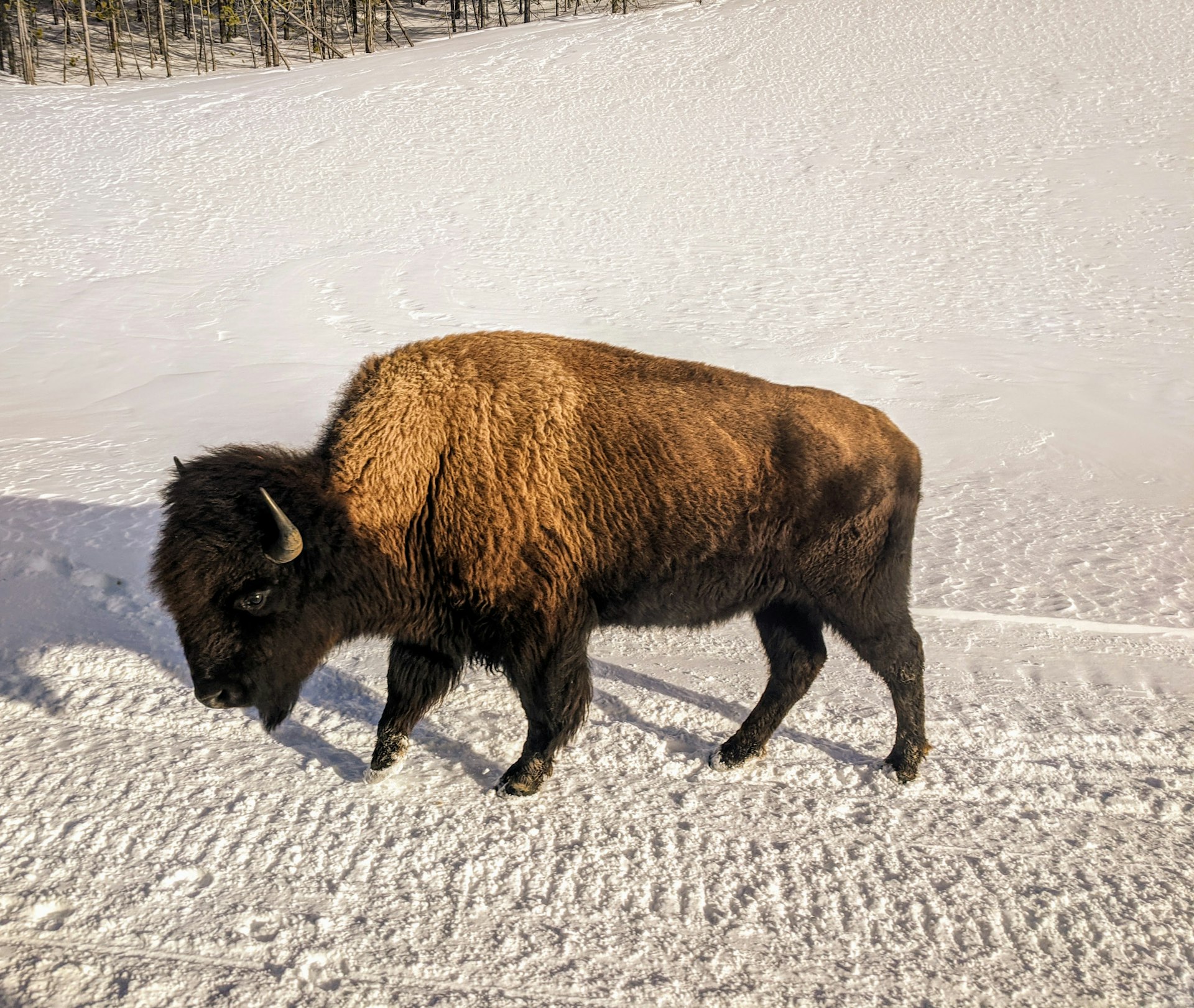
Yellowstone Wildlife
Bison are everywhere in Yellowstone and you're sure to see some any time of year – possibly quite close, as they aren't shy about stopping traffic to cross the street or amble down the road at their own pace. While it's important to keep your distance, stay in your vehicle, and never, ever feed wildlife of any species, the chance to see one of North America's most iconic animals in its natural habitat is something special indeed.
That said, there are many more animals to view in Yellowstone than just these fuzzy giants, and you'll be sure to see many visitors armed with telescoping lenses and binoculars who are hoping to get a glimpse of the park's permanent residents, including grey wolves, elk, moose, mountain goats, bears, lynx, coyotes, mule deer, foxes, otters, and wolverines.

One of the best ways to see wildlife is to visit in the winter and take a tour on one of Yellowstone's snow coaches. The park's knowledgeable, close-knit team of guides are well-versed in where to find wildlife day-to-day and have the best shot at getting you where you need to be to catch a glimpse. Plus, they do the driving so you're free to keep your eyes peeled and your hands on your camera to catch thrilling split-second moments like foxes diving high in the air to "plonk" down on their prey.
Watching wildlife in Yellowstone National Park

Hiking and Backpacking
Yellowstone doesn't have quite the athletic reputation of parks like Yosemite, Arches, or Zion, which are practically synonymous with American rock climbing and canyoneering. But there's plenty in Yellowstone best seen from the trail or ski track to please outdoor enthusiasts of all skill levels – just remember to pick up a backcountry camping permit if you'll be heading out on overnight.
Morning Glory Pool sits not far from the Upper Geyser Basin and is well worth adding a little extra perambulation. The colors are even more brilliant in person than in photos, set off by lush, muted stands of evergreens.
Lone Star Geyser can be reached by hike, mountain bike or cross-country ski tracks – an outing which follows a picturesque section of the Firehole River to an impressive 45-foot high gusher that erupts roughly every three hours. Coincidentally, that's about long it'll take you to make the out-and-back if you're on foot.
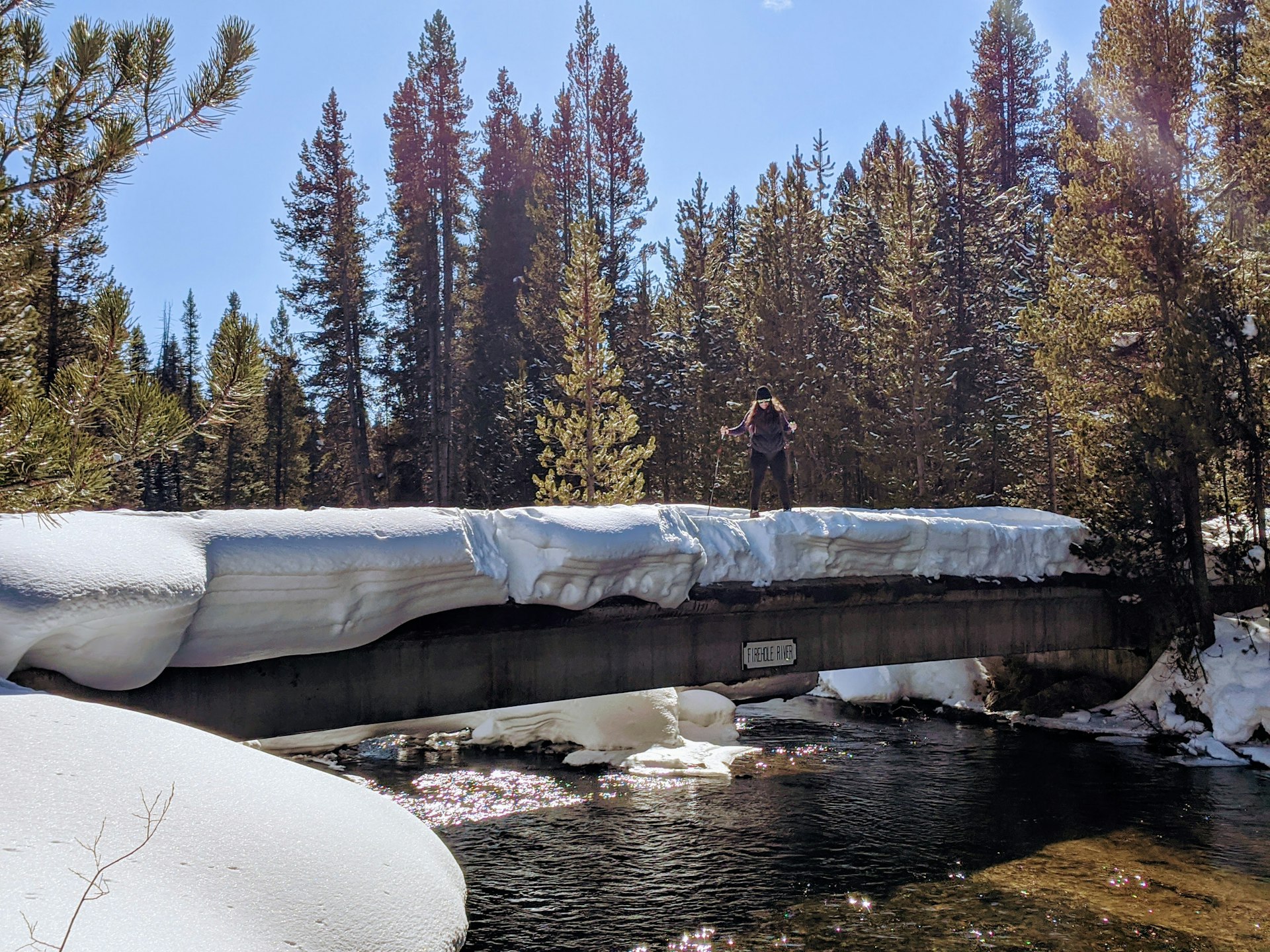
Bunsen Peak is a moderate to challenging hike of under five miles that's named for the same gent who invented the Bunsen burners you might have used in high school chemistry class. It offers expansive views of the northern part of the park around Mammoth Hot Springs – especially with the residual effects of the 1988 fires that swept through Yellowstone.
Electric Peak is a strenuous undertaking, spanning 20 miles of prime Yellowstone terrain and 3,808 feet of elevation gain and loss. Bring your bear bells and you'll be rewarded with panoramic views, fields of goldenrod, and glimpses of Yellowstone's varied geologic layers as you climb to the summit. You might even see a moose, especially if you turn this from a dawn-to-dusk day hike into a short backpacking trip.
The Black Canyon of the Yellowstone is a hard 13 miles, but it's full of adventurous details like a suspension bridge over the Yellowstone River, the cascade of Knowles Falls, and ancient rock slides. Follow in the footsteps of Teddy Roosevelt, early Yellowstone explorers, and even miners as you make your way to Eagle Creek Campground and back.
Insider’s guide to Yellowstone: where to trek and geyser gaze without the crowds
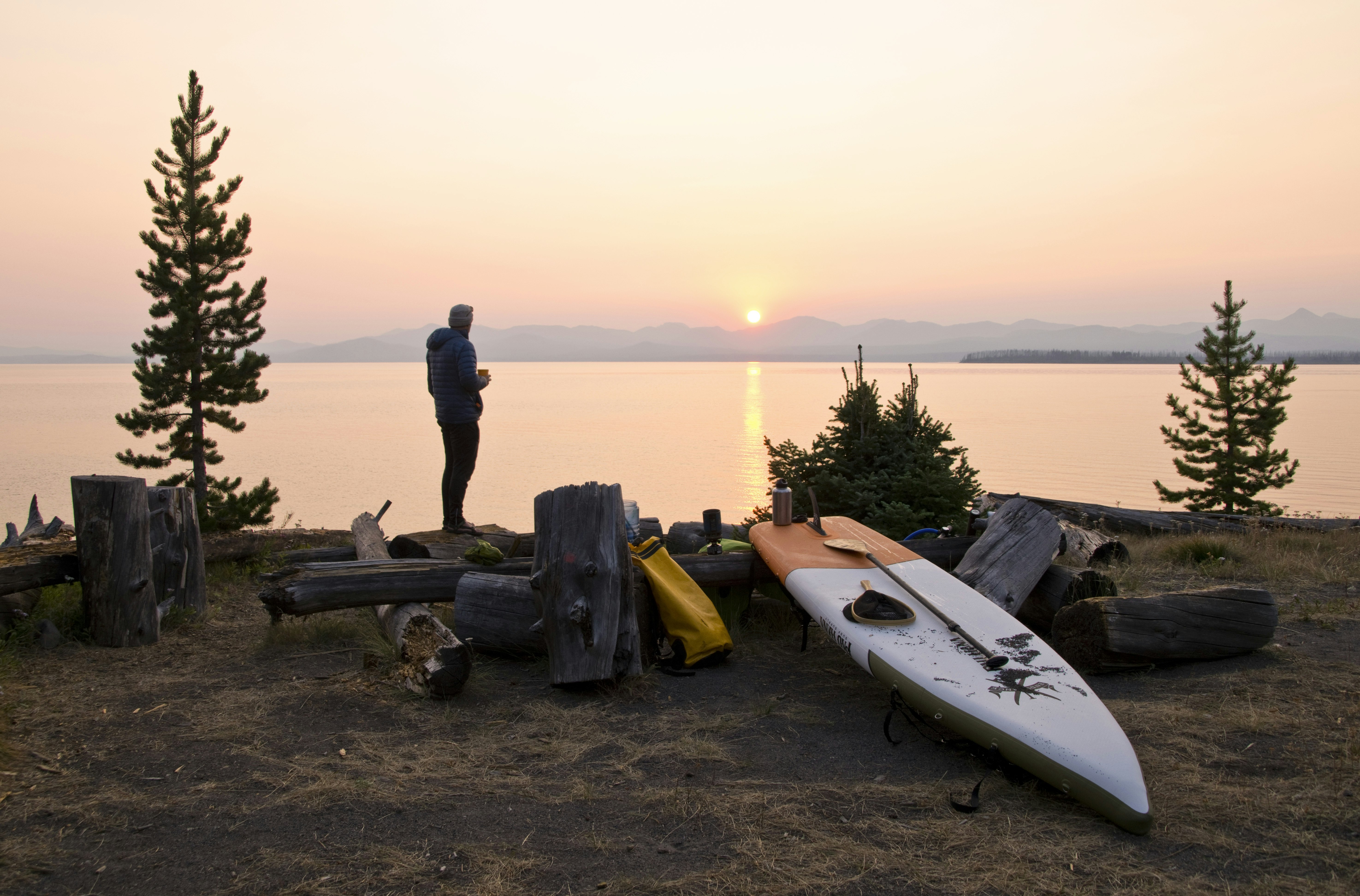
Watersports in Yellowstone
You can't take your kayak out on Yellowstone's streams – fair enough, since half of them have well-earned names like the Boiling River. But you can paddle Yellowstone's lakes and ponds, including Yellowstone Lake, Lewis Lake, and Shoshone Lake. There's a lot to see that's well worth the upper body workout.
Anglers will be rewarded with abundant fish, including some species native to the park. Wildlife watchers will appreciate the opportunity to observe fauna on the shore without ending up in a bison jam or rubbing elbows with other visitors. And yakpackers have the unique ability to reach remote areas of the park not on foot, but one paddle stroke at a time.
You can book guided river rafting trips out of Gardiner, Montana to shoot the Yellowstone River's rapids, kayak tours, and even overnight paddle expeditions if you don't have your own watercraft, or are traveling long-distance. You can also rent rowboats and outboards at Bridge Bay Marina, or a variety of watercraft from private companies outside the park.
The extra-adventurous can bring their dive gear and explore under the surface of Yellowstone Lake, West Thumb Geyser Basin, and the Firehole River at Mystic Falls – all under-the-radar national park scuba destinations.
Everything you need to know about paddling in Yellowstone National Park

When to Visit
Yellowstone is open to visitors year-round, though it closes for two short shoulder periods a year to transition between seasons. Yellowstone generally closes between March through April each year to give crews time to plow the roads and prepare the park for peak season. The park also shuts down in September and October to winterize its infrastructure.
Summer
The most popular months to visit Yellowstone are July and August when families are on summer vacation and temperatures are the warmest. If you want to avoid significant crowds, it's better to come at the beginning or end of the summer season, though temperatures might be a little cooler.
During the summer, weather in Yellowstone is warm and pleasant during the day, with highs in the 60s and 70s, but can still dip down into the 30s and 40s (Fahrenheit). It's always wise to pack layers and sunscreen, and to ere on the side of camping gear rated for lower temperatures.

Winter
Winter in Yellowstone is criminally overlooked, with prime opportunities for viewing wildlife like bison, elk, foxes, weasels, and even the park's famous wolves. You'll also face next to no crowds, except around Christmastime, giving you ample opportunity for photos or simply soaking up the contrast of fire and ice uninterrupted.
In winter, temperatures can hover around zero or below, though the low humidity makes it easy to layer warmly, especially if you're planning an active day of snowshoeing or skiing. Avoid cotton clothing in favor of wicking, insulating fabrics like silk, wool, or synthetic base layers, and make sure you have good socks and gloves.
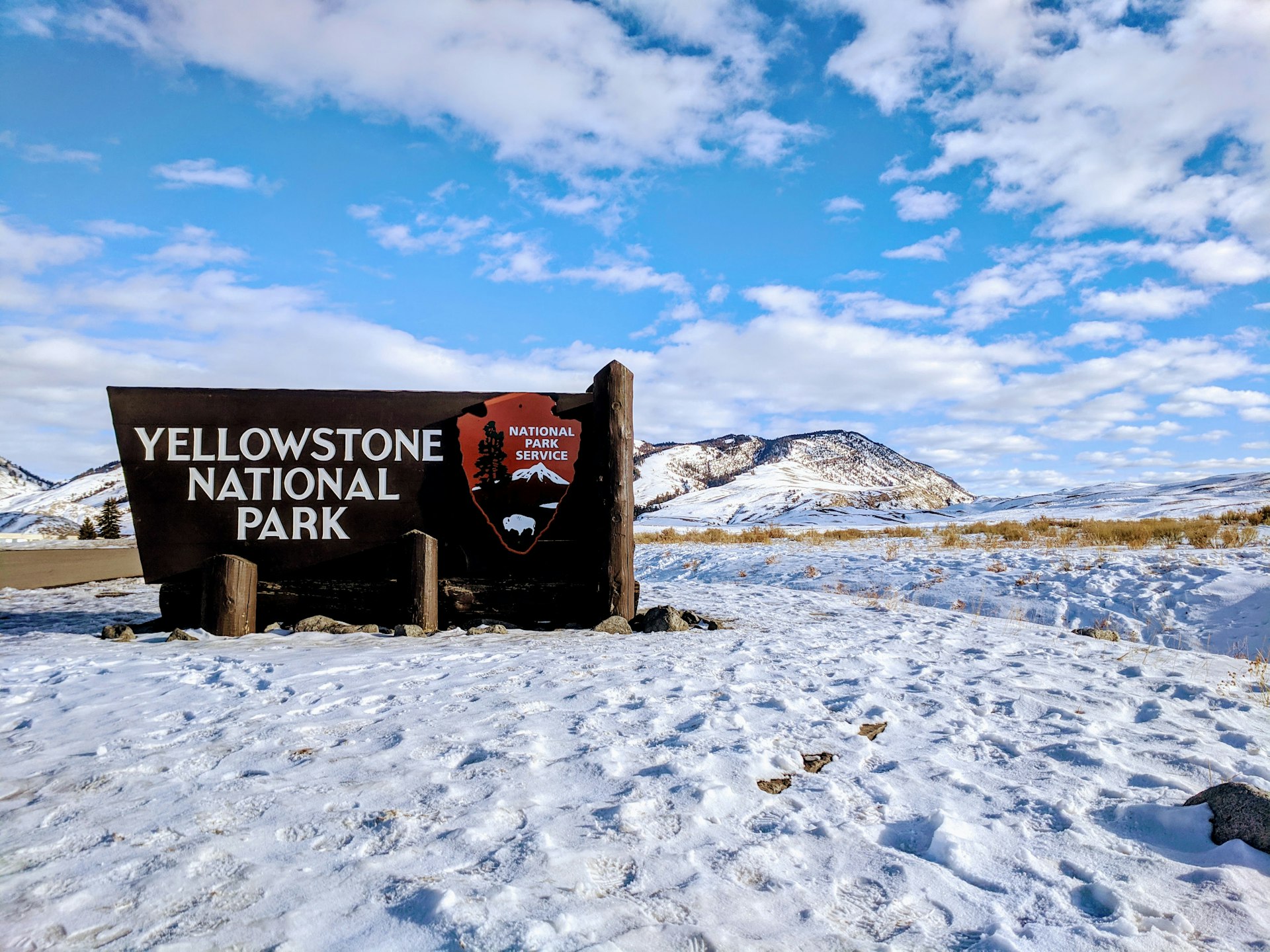
Getting There and Getting Around
By Air
The easiest way to reach Yellowstone is by flying into one of the region's airports, including Jackson, Wyoming; Bozeman, Montana or Idaho Falls. Cody, Wyoming and Billings, Montana are also options. In peak season, you can also fly directly into West Yellowstone, Montana.
Bozeman is often the best deal and is a very fun college town with plenty to see and do on your way in and out. Grab a beer and a bite at Montana Ale Works if you have the chance. Meanwhile, Jackson, Wyoming has earned its outsize reputation as a mountain town worthy of a vacation in its own right – swing by Snake River Brewing if time allows, where you will run into everyone from young guns to backwoods mystics to thoughtful western old timers.

By Road
Highways 20, 191, 89, 212, and 14/16 all connect to or border Yellowstone National Park, depending on whether you're driving in from Montana, Idaho or Wyoming. You can make a road trip of reaching Yellowstone from Jackson by driving north through Grand Teton National Park. Another option is to drive west from Devil's Tower National Monument on the Wyoming/North Dakota border, or northeast from Craters of the Moon – which will give you a sense of just how much power the Yellowstone hotspot has packed in millennia past.
Once you are within the park, there are a few main roads linking the five entrances to the park, including the Grand Loop Road, Norris Canyon Road, West Entrance Road, North Entrance Road, South Entrance Road, and East Entrance Road. The only road open in the winter months is the Grand Loop Road to 212 through Tower Junction between the North Entrance at Gardiner, Montana and Cooke City Montana.
Patience is a virtue, as in most popular national parks. Traffic can be slow in peak season when the park is most crowded, especially if there's a "bison jam" caused by tourists stopping int he middle of the road to snap photos of nearby wildlife. Keep calm and keep your eyes open – and don't forget to fill up at Yellowstone's handful of gas stations when you have the chance.

Where to Stay
Summer Lodging in Yellowstone
In summertime, you'll have your pick of accommodations from lodges to cabins to campgrounds and even yurts, with a wide range to choose from within each category depending on your style and what part of the park in which you'd prefer to be based.
Especially in peak season, you'll want to book accommodations well ahead of time, especially if you're hoping for a prime room in the Old Faithful Lodge or your pick of campsites. Yellowstone can book out months or even a year in advance, even in a year when travel has been curtailed by a global pandemic.
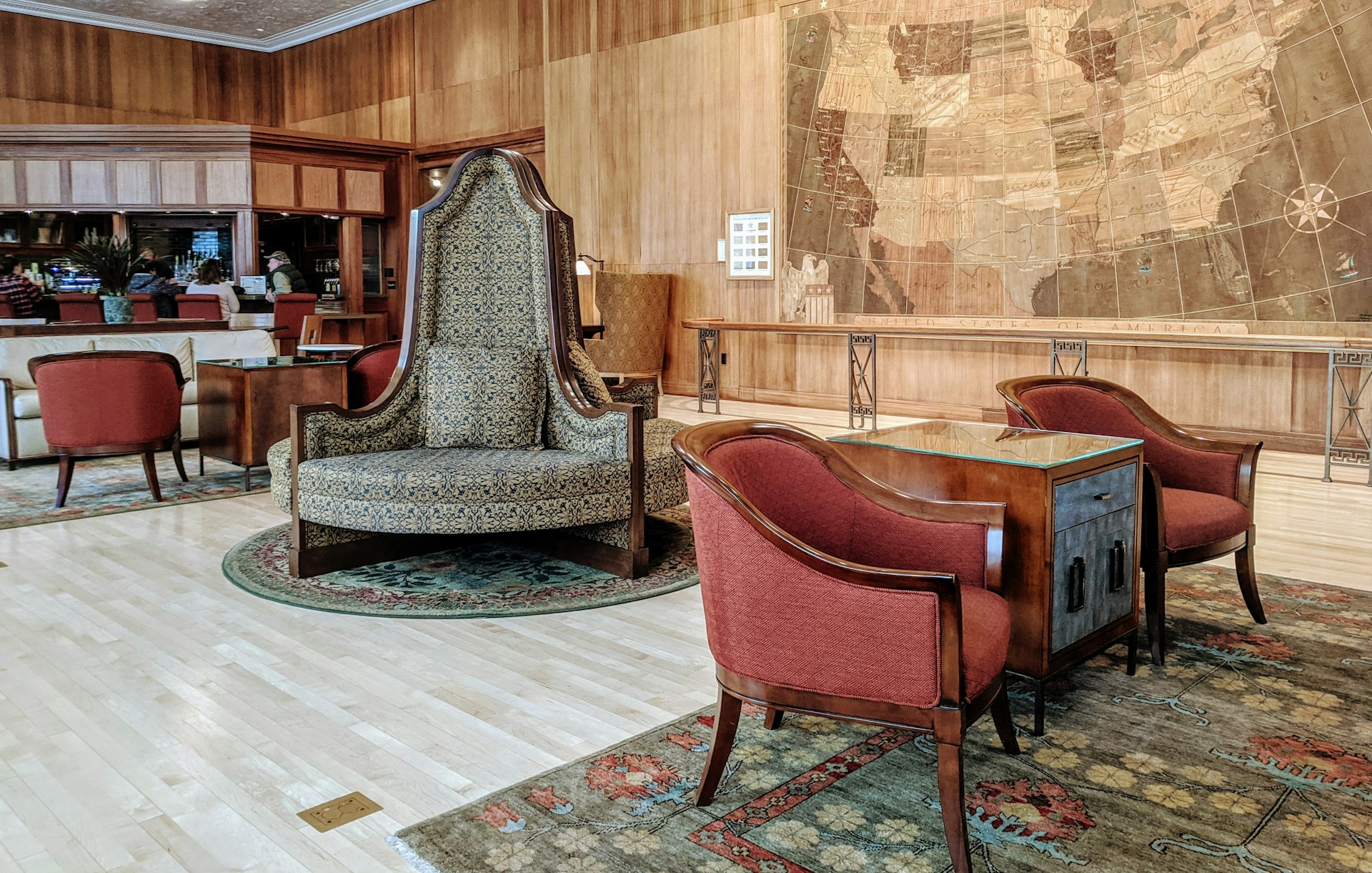
Hotels
The iconic Old Faithful Inn, completed in 1904, is a prime example of "parksitecture" and is a testament to over a century of Yellowstone Visitors, close to both Old Faithful and the Upper Geyser Basin. The massive stone fireplace is a dreamy place to curl up after a long day of sightseeing, too.
The Mammoth Hot Springs Hotel is another gorgeous piece of Yellowstone history – parts of it date back to 1911, but most was built in 1936. The whole place was recently renovated, with chic updates to the guest bathrooms and many improvements made with sustainability in mind, like the recycled glass countertops. Don't miss a meal at the dining room across the street – the Elk Sliders with tarragon aioli are a treat, and the Bison Top Sirloin is especially memorable.

Grant Village, constructed in the 1980s, is tucked away near both Yellowstone Lake and Grand Teton National Park on the southern side of YNP. Visitors will especially appreciate the stunning views from the Lake House Restaurant and Grant Village Dining Room.
Lake Yellowstone Hotel was most recently updated in 2014, also with an emphasis on sustainability. The hotel swaps rustic charm for Colonial Revival glam and boasts some of the better internet connectivity in Yellowstone.
Canyon Lodge is the newest addition to the Yellowstone's collection of accommodations. This LEED-certified development gives you prime access to the Grand Canyon of Yellowstone, and is a contemporary take on the classic parksitecture found at the Old Faithful Inn.
11 sustainable ways to experience Yellowstone National Park

Cabins and Cottages
Cabins and cottages are available throughout the park as well, with options at Lake Yellowstone, Lake Lodge, Canyon Lodge, Roosevelt Lodge, Mammoth Hot Springs, Old Faithful Snow Lodge, and Old Faithful Lodge.
Cabins typically come with two options – those with their own baths including showers but not tubs, or those with sinks but shared bathroom facilities. The exception to this are the new Canyon Lodge Cabins, which have full bathrooms. The most historic is the Roosevelt Lodge Cabins, built in the 1920s near Tower Junction.

Campgrounds
Like other types of lodging, camping is available throughout Yellowstone at Madison Campground, Grant Village, Canyon Campground, and Bridge Bay Campground.
RVs can be no longer than 75 feet to navigate Yellowstone's roads, but most campsites cannot accommodate rigs long than 40 feet. Be sure to read up on length limits when choosing a campsite in Yellowstone as they vary from campground to campground.
Madison Campground and Canyon Campground the most conveniently located for seeing as many different areas of Yellowstone as possible. Grant Village is excellent for families and first-time campers, with easy access to the amenities at the nearby hotel. Canyon Campground and Bridge Bay are some of the most scenic places to camp.
Rangers patrol the campgrounds frequently to make sure you're complying with bear safety protocols and other regulations – so be sure to read up ahead of time on safe food storage practices and use the provided bear lockers. You can purchase firewood at check-in, and campsites are typically equipped with fire rings and picnic tables, and space to park your car.

Backcountry Camping
While backcountry camping is currently closed due to COVID-19, there are 300 sites within Yellowstone. Because Yellowstone is so rugged and remote, and because it's home to bears and other apex predators, it's important to have some backcountry experience before taking advantage of these sites, and to be well-versed in Leave No Trace principles.
When there isn't a pandemic on, you can obtain permits within 48 hours of your visit from any of nine different ranger stations and visitor centers. Some can be reserved farther in advance, but are awarded by lottery starting April 1st from a running pool of reservation requests submitted by mail, fax, or in-person.

Winter Lodging in Yellowstone
In the winter months, Yellowstone operates limited facilities including the Old Faithful Snow Lodge and Mammoth Hot Springs Hotel. These are open from mid-December to the first of March. Mammoth Hot Springs Hotel can be reached from Gardiner, Montana in private vehicles, but during the winter season the Old Faithful Snow Lodge can only be accessed by commercial snow coaches.
While the Old Faithful Snow Lodge was built in 1999, its architecture is faithful to the period style of the neighboring Old Faithful Inn, and offers plenty of rustic romance. There are cozy fireplaces surrounded by welcoming club chairs, a bar and restaurant that turn out a delicious and varied menu (get the huckleberry pancakes), as well as ski and snowshoe rental onsite.
There's an ice skating rink just steps from the Snow Lodge entrance and in the evenings you can enjoy an outdoor fire pit – preferably after a tipple of MT 1889 Whiskey or a Big Sky Brewing's Moose Drool Brown Ale at the Firehole Lounge. If you get lucky, you might even spy some bison wandering just outside from the Geyser Grill dining room – they sometimes like to check out the Upper Geyser Basin themselves.
You might also like:
The complete guide to Mammoth Cave National Park
From stagecoach to motorcoach, a history of RVs in the USA
Our top 10 picks for backpacking cooking gear
Make sure you're ready for anything with travel insurance from our trusted partners. Check out adventure tours for every traveler from our trusted partners.
